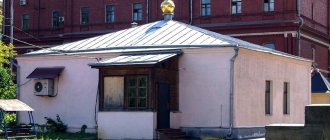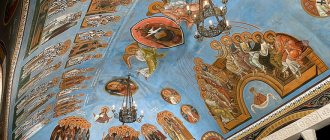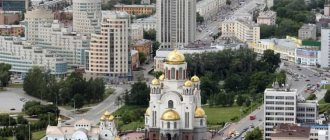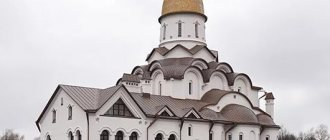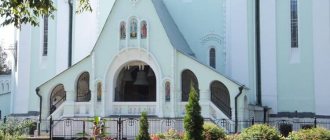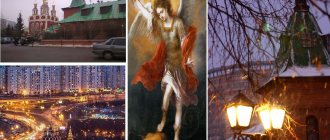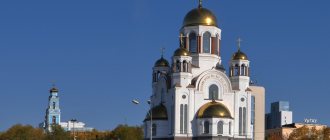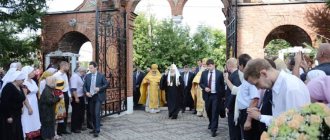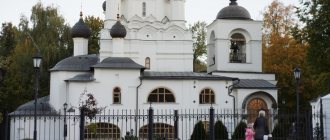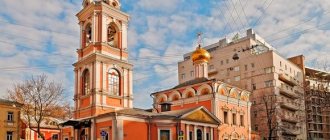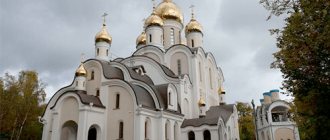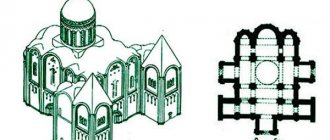What's the best way to get there?
The Church of All Saints on Kulishki is located in historical] Moscow[/anchor]. Therefore, everyone who wants to visit it by private car should be prepared for all the difficulties that accompany such a trip. If you still decide to travel by car, follow this route.
- From Varshavskoye Highway, turn onto Novodanilovsky Proezd, then left onto Novodanilovskaya Embankment and through Danilovskaya, Paveletskaya, Derbenevskaya, Shlyuzovaya, Kosmodemyanskaya embankments to the Bolshoi Ustinsky Bridge.
- Then turn right to Solyanki Street, left, and follow it to Solyansky Proezd. Then turn left to Lubyansky Proezd, turn around towards Old Square and drive to Slavyanskaya Square, your destination.
- The best way to get to the Church of All Saints on Kulishki is by metro. Directly next to the building is the southern lobby of the Kitay-Gorod on the Tagansko-Krasnopresnenskaya line.
- You can get to the temple by land transport. Buses No. 38, 101, 144, 158, 904, m7, m7k, m2, m8, m9, m10 are suitable. You need to go to the stop “Kitay-gorod metro station” .
Interesting facts from the history of the Church of All Saints on Kulishki
- It is believed that the temple was erected in 1380 on the orders of Grand Duke Dmitry Donskoy as a memory of the soldiers who died on the battlefield of Kulikovo. Although many historians are inclined to believe that a wooden church stood on this site even before these events.
- In 1488 it was completely made in stone. The temple suffered during the hard times of the Time of Troubles and was restored only towards the end of the 17th century . After that, it was rebuilt and updated several times.
- The temple turned out to be at the center of tragic events during the Plague Riot. A rumor spread throughout the city that the plague was sent for insufficient veneration of the Bogolyubskaya Icon of the Mother of God , which was located on the Varvarskaya Tower and belonged to the parish of the Church of All Saints. Thousands of Muscovites rushed to the walls to venerate the image, and the clergy decided to hide the icon in the temple to avoid crowds, which only intensified the epidemic. A riot broke out, during which the archbishop was killed and many townspeople were injured.
- The temple existed peacefully until the first years of Soviet power, and was closed in the 1930s. It was even planned for demolition, but was handed over to state security agencies for special purposes. What these needs were became clear when human remains with traces of gunshot wounds were discovered in the basement in the 1990s.
- In the 1980s, the restoration of the temple was completed.
- In the 1990s, the temple was returned to the parish, and services began to be held there again.
- In 1998, a metochion of the Alexandrian Orthodox Church was located in the Church of All Saints.
- Regular services are held in the temple, there are arks with particles of holy relics , especially revered icons , including the Mother of God of Tikhvin , the Most Holy Theotokos “of the Sign”, and the Mother of God “Merciful” .
Current state[edit]
Architecture[edit]
The architecture of the church dates back to the early Baroque and is an intermediate link between the churches of Peter the Great and the developed Baroque buildings of the mid-18th century. Churches of this era are characterized by heavy proportions.
The church has a three-part longitudinal-axial “ship” structure. The architecture of the building belongs to the common type of “Eight on a Quad”. Adjacent to the quadrangle (the main volume) is a two-limit refectory, a semicircular apse and a bell tower of the same width. The octagon covered with a closed vault does not play a significant role in the volumetric composition of the church. It rests on the walls of the quadrangle and on the stepped tromps. From the outside, the figure of eight is perceived as a pedestal for the dome. In the vault of the temple there are large false lucarne windows, which appeared in the late 1960s (in the 2000s the lucarnes were sealed and painted on the outside). The walls of the refectory have large semicircular windows, between which there are side pilasters and horizontal cornices.
The bell tower of the All Saints Church has three tiers and was built entirely in the style of Moscow architecture of the early 18th century. An octagonal pillar rests on the two-tier base of the bell tower. It has narrow arched bell openings. A characteristic feature of the bell tower are the semi-domes in the tympanums, which visually soften the transition from the quadrangle to the octagon. The staircase to the bell tower begins in the thickness of the western wall of the refectory and has its own entrance from the outside.
The temple underwent significant reconstruction. Initially, the refectory had four round columns on which the vault rested. In 1886, according to the design of the architect A.P. Popov, the refectory was rebuilt: the columns were removed, a single vault was erected, and the walls were raised. In 1902-1903, according to the design of the architect N. N. Blagoveshchensky, the refectory was rebuilt again: the side aisles were expanded.
The bell tower of the temple is often called one of the “Leaning Towers of Pisa” in Moscow - it has an inclination of about 5 degrees. There is an opinion that the tilt of the bell tower occurred due to the influence of the waters of the Tarakanovka River, enclosed in a collector, the proximity of the metro and the characteristics of the soil (it is no coincidence that the local streets are called Sandy).
Interior[edit]
The temple has wall paintings inside. The largest pictorial composition in the church, “The Cathedral of All Saints,” is located above the main iconostasis. It was made in the late 1940s in the Vasnetsov style. The composition depicts Orthodox saints in prayer. Among them are saints revered in Georgia: Nina, Tamara and Daria. On the walls of the octagon, on the vault of the temple and in the apse, oil paintings, executed in 1884 in the manner of late academicism, have been preserved. Some of the temple's paintings were done in the 1960s.
The central carved iconostasis was made in the late 1940s in the pseudo-Russian style. It has three tiers. The iconostases of the side chapels were also made at the same time. The color of the iconostasis is white-cream with gilding. In the western part of the refectory, above the entrance, there are choirs. Several memorial plaques dedicated to the priests and representatives of the Georgian princely families buried here have been preserved on the walls of the temple.
Cemetery at the temple[edit]
The cemetery at the Church of All Saints has been known since the 18th century. Many representatives of the Georgian princely families (Bagrations, Tsitsianovs and others) were buried here. According to some reports, the Georgian writer Sulkhan-Saba Orbeliani is buried at the All Saints Cemetery. At the end of the 19th century, wealthy peasants were buried in this cemetery. At the same time, ancient gravestones were often destroyed or moved from place to place.
The cemetery existed until 1982, after which it was destroyed by order of the liquidation of cemeteries within Moscow. According to one version, high-ranking residents of the neighboring “General’s House” contributed to the demolition of the tombstones. Many of them were not happy with the view of the cemetery from the window.
Nevertheless, some tombstones have survived to this day. Among them is the tombstone of Prince Ivan Alexandrovich Bagration (1730-1795). The monument was erected at the grave by his son, the great commander Pyotr Ivanovich Bagration. The monument is a fluted pyramid on a high pedestal. The tombstone of I. A. Bagration repeatedly changed its location. Now it is installed to the north of the temple near the “Reconciliation of Nations” memorial. The tombstone of I. A. Bagration is a historical monument of federal significance.
Memorial "Reconciliation of Peoples"[edit]
The memorial “Reconciliation of the peoples of Russia, Germany and other countries who fought in two world and civil wars” was installed in 1994-1998 on the territory of the Church of All Saints on the initiative of a group of veterans of the Great Patriotic War and other private individuals[30]. It includes several memorial plaques and crosses dedicated to the victims of the Crimean, Balkan, Russo-Japanese, World War I, Civil and First Chechen wars, as well as victims of the Red Terror, representatives of the White movement and Cossacks. Some of the monuments were initially installed on the territory of the former Moscow City Fraternal Cemetery, and then moved to the Church of All Saints.
The installation of a slab dedicated to the commanders of the 15th SS Cossack Cavalry Corps, which fought in World War II on the side of Nazi Germany, caused a wide public outcry. Attempts were made repeatedly to achieve the demolition of this monument, but they were unsuccessful. On May 8, 2007, on the eve of Victory Day, the slab was broken by unknown persons (according to the Moskovsky Komsomolets newspaper, the slab could have been broken by members of one of the radical left organizations). The rector of the temple, Archpriest Vasily Baburin, noted that this slab has nothing to do with the Church of All Saints. A small fragment remained from the monument until in 2014 it was replaced with a slab “To the Cossacks who fell for the Faith, the Tsar and the Fatherland.”
Activities of the parish[edit]
The church has a Sunday school for children and a children's choir. Sunday school for adults, singing school, Church Slavonic language courses. Youth organization, pilgrimage service, social service group, prisoner assistance group.
Photo of the Church of All Saints on Kulishki
The central facade of the temple, the original design of the superstructure immediately catches the eye.
View of the temple from a different angle, you can clearly see the bell tower.
At night, the Church of All Saints on Kulishki looks mysterious.
The Church of All Saints on Kulishki will greet you with a sign near the entrance.
The Church of All Saints on Kulishki looks like this from a different angle.
The Church of All Saints on Kulishki, inside which there is a beautiful iconostasis.
Shrines[edit]
Reliquary
- Holy myrrh from the myrrh-streaming heads of the Kiev-Pechersk saints
- Stone of Mount Sinai
- St. stone Seraphim of Sarov
- Stone of the coffin of St. Leonida
- Nail from the coffin of St. Ambrose of Optina
- Palma St. Savva the Sanctified
- Part of the Life-Giving Cross of the Lord
- Part of St.'s clothing Philaret of Moscow
- Part of the mantle of St. Seraphim of Sarov
- Part of the mantle of St. John, new Jerusalem
- Kazan Icon of the Mother of God
- Icon of St. Nicholas the Wonderworker
- Icon of All Saints
- Icon of the Mother of God “Joy of All Who Sorrow”
- Pieces of the relics of many saints
Church of All Saints on Kulishki on video
Despite the fact that the Church of All Saints is surrounded by more modern buildings, it looks very organic in the historical center of Moscow. There is a very pleasant, warm atmosphere in and around the temple. Lots of old icons, original decoration. Watch an interesting video about this temple.
It was very interesting to discuss the history of the temple with friends. I heard that the church has sunk more than three meters into the ground over the entire history of its existence. If anyone has confirmation of this information, please share it in the comments.
Architecture
Truly, the All Saints Church in Minsk amazes with its monumentality, festive elegance and splendor. From any point of view it maintains its symmetry. A high staircase visually increases the size of the structure. Elevators are available for the infirm and elderly parishioners.
Chief architect Lev Nikolaevich Pogorelov said about his creation: “I won’t design anything else. This is my favorite object, my swan song."
And indeed, soon after the construction of the church in the capital of Belarus, the great architect died. The architect's idea to combine the historical heritage of the past with the construction technologies of the present to build a message to the future, for the edification of descendants, was embodied in stone. All Saints Church is 74 meters high, including the cross. The shape of the building is traditional for Orthodox architecture - it is a tent, which is a symbol of the Mother of God, and a cross crowning it, denoting Jesus Christ. The base of the tent has the shape of an octagon. On the sides of the main tent there are two chapels - this is also a symbol, standing on the right and left hand of the Mother of God and Christ - the faithful sons of the Fatherland, defenders of the Orthodox Faith, who died in battles for the Fatherland.
The temple is very spacious; its territory can accommodate more than 1000 believers at a time.
